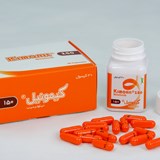INDICATIONS
Adult and pediatric patients greater than or equal to 1 year of age with newly diagnosed Philadelphia chromosome positive chronic myeloid leukemia (Ph+ CML) in chronic phase.
Adult patients with chronic phase (CP) and accelerated phase (AP) Ph+ CML resistant to or intolerant to prior therapy that included imatinib.
Pediatric patients greater than or equal to 1 year of age with Ph+ CML-CP resistant or intolerant to prior tyrosine-kinase inhibitor (TKI) therapy.
DOSAGE AND ADMINISTRATION
Recommended Adult Dose:
Newly diagnosed Ph+ CML-CP: 300 mg orally twice daily. Resistant or intolerant Ph+ CML-CP and CML-AP: 400 mg orally twice daily. (2.1)
Recommended Pediatric Dose: Newly Diagnosed Ph+ CML-CP or Ph+ CML-CP resistant or intolerant to prior TKI therapy: 230 mg/m2 orally twice daily, rounded to the nearest 50 mg dose (to a maximum single dose of 400 mg).
Eligible newly diagnosed adult patients with Ph+ CML-CP who have received Nilotinib for a minimum of 3 years and have achieved a sustained molecular response (MR4.5) and patients with Ph+ CML-CP resistant or intolerant to imatinib who have received Nilotinib for at least 3 years and have achieved a sustained molecular response (MR4.5) may be considered for treatment discontinuation.
specifications
WARNINGS AND PRECAUTIONS
Myelosuppression: Monitor CBC during therapy and manage by treatment interruption or dose-reduction.
Cardiac and Arterial Vascular Occlusive Events: Evaluate cardiovascular status, monitor and manage cardiovascular risk factors during Nilotinib therapy.
Pancreatitis and elevated serum lipase: Monitor serum lipase; if elevations are accompanied by abdominal symptoms, interrupt doses and consider appropriate diagnostics to exclude pancreatitis.
Hepatotoxicity: Monitor hepatic function tests monthly or as clinically indicated.
Electrolyte abnormalities: Nilotinib can cause hypophosphatemia, hypokalemia, hyperkalemia, hypocalcemia, and hyponatremia. Correct electrolyte abnormalities prior to initiating Nilotinib and monitor periodically during therapy.
Tumor lysis syndrome: Maintain adequate hydration and correct uric acid levels prior to initiating therapy with Nilotinib.
Hemorrhage: Hemorrhage from any site may occur. Advise patients to report signs and symptoms of bleeding and medically manage as needed.
Fluid retention: Monitor patients for unexpected rapid weight gain, swelling, and shortness of breath. Manage medically.
Effects on Growth and Development in Pediatric Patients: Monitor growth and development in pediatric patients.
Embryo-Fetal toxicity: Advise patients of potential risk to a fetus and to use effective contraception.
DRUG INTERACTIONS
Strong CYP3A inhibitors: Avoid concomitant use with Nilotinib, or reduce Nilotinib dose if co-administration cannot be avoided.
Strong CYP3A inducers: Avoid concomitant use with Nilotinib.
Proton Pump Inhibitors: Use short-acting antacids or H2 blockers as an alternative to proton pump inhibitors

kimonil
|